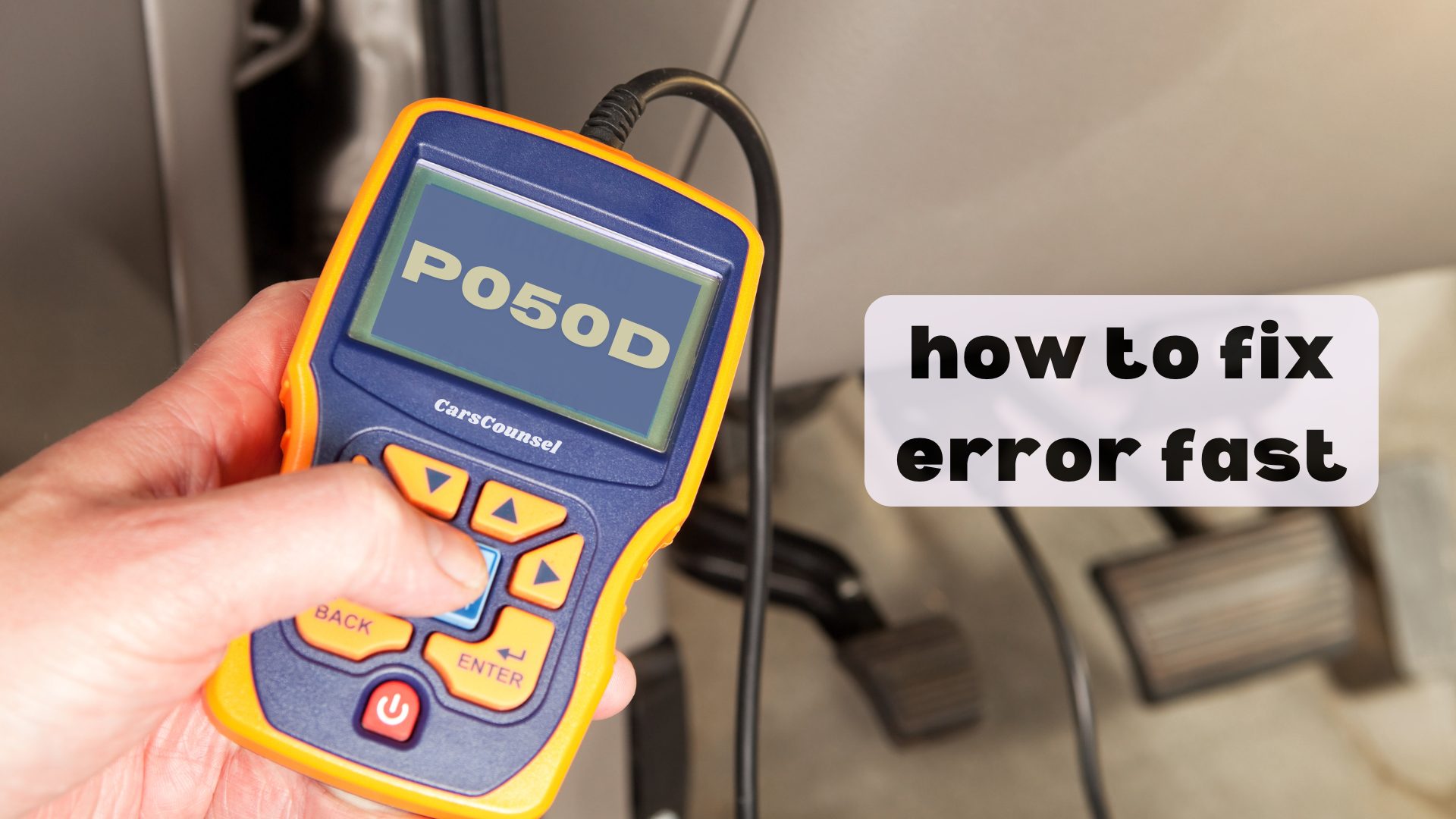If you’re dealing with a P050D code, the fastest way to fix it is by using an OBD-II scanner to confirm the OBD2 problem.
Once you’ve confirmed it, check the idle air control valve, throttle body, and vacuum lines for any damage or buildup. Often, a good cleaning of these parts can fix the issue.
If the problem continues, you might need to test and possibly replace the mass airflow sensor.
Regular maintenance can help prevent this code from coming back.
Want to make sure your engine runs smoothly? Here’s what you need to do.

Quick Navigation
Key Takeaways
- Check and Clean Throttle Body: Look for dirt or carbon buildup and clean it well to ensure proper airflow.
- Inspect Idle Air Control Valve: Check for damage or carbon buildup and clean or replace it if needed for a steady idle speed.
- Look Over Vacuum Lines: Check for cracks or disconnections and fix any leaks to keep the air intake stable.
- Test and Clean Mass Airflow Sensor: Use a multimeter to check the sensor readings and clean it with a mass airflow cleaner if the readings are off.
What Is the P050D Code?
When your car’s diagnostic system finds a problem with the cold start idle air control, it sets off the P050D code. This code means your engine’s idle speed isn’t being properly controlled during cold starts.
Ignoring the P050D code can cause your car to idle roughly, reduce engine performance, and increase emissions. If you don’t fix it, you could also damage engine parts and fail emissions tests.
Common issues causing this code include faulty sensors or problems with the throttle body that affect idle speed. Taking care of the P050D code right away ensures your car runs well and helps you avoid expensive repairs.
Causes of the P050D Code
The P050D code can pop up for several reasons, most of which involve problems with the idle air control system and its parts. Here are some common causes:
- Bad Idle Air Control Valve: If this valve isn’t working right, your car’s idle speed can go up and down, messing with engine performance.
- Dirty or Clogged Throttle Body: When the throttle body gets dirty, it can’t control the air coming into the engine properly, which can make the idle speed unstable.
- Vacuum Leaks: These leaks let in unregulated air, which can make your car’s idle speed jump around.
- Faulty Mass Airflow Sensor: If this sensor isn’t measuring the air coming into the engine correctly, it can mess with how much fuel is injected, affecting idle speed.
- Problems with the Engine Control Module (ECM): If the ECM is giving wrong readings for idle speed, that can cause issues too.
- Damaged Vacuum Hoses and Bad Electrical Connections: These can also mess with your engine’s performance and contribute to the P050D code.
To fix the P050D code, you’ll need to check and address these parts.
Symptoms to Watch For
If the P050D code comes up, you might notice your engine stalling when you’re idling or driving at low speeds. This can mess with how well your engine runs when it’s idling.
Watch out for these symptoms:
- Engine stalling when you’re idling or going slow.
- Worse fuel efficiency, meaning you’ll need to refuel more often.
- RPMs going up and down when the car is stopped, showing idle issues.
- Check engine light turning on, indicating a problem.
Catching these signs early can help you fix the problem quickly, keeping your engine running well and avoiding more issues later.
Pay attention to any changes in how your car behaves to spot problems early.
Initial Diagnostic Steps
To start diagnosing the P050D code, use an OBD-II scanner to confirm that the code is present and to gather any other trouble codes that might give you more information. These tools are key for initial troubleshooting.
Once you’ve confirmed the P050D code, check the freeze frame data to see when the issue happened.
Next, do a visual inspection of the throttle body and air intake to look for any blockages or dirt buildup.
Also, check the idle air control valve for any damage or wiring problems.
Finally, inspect all the vacuum lines for leaks or damage, as unregulated air can mess with the idle speed.
Following this step-by-step approach ensures accurate diagnostics and efficient problem-solving.
Inspecting the Throttle Body
Checking the throttle body means looking for any dirt, carbon buildup, or blockages that might mess with the air intake and affect the idle speed.
To properly clean and maintain the throttle body, follow these steps:
- Disconnect the battery: Always prioritize safety by disconnecting the battery first.
- Remove the air intake hose: Gently take off the hose to get to the throttle body.
- Look at the throttle plate: See if there’s any residue or buildup on it.
- Clean with throttle body cleaner: Use an appropriate cleaner to get rid of any deposits.
Cleaning the throttle body is crucial to ensure good air intake, prevent idle problems, and boost engine performance.
Regular checks can help you avoid issues like the P050D code and keep your car running smoothly.
Checking the Idle Air Control Valve
After making sure the throttle body is clean, the next step is to check the idle air control valve for any problems or wear.
First, find the valve, usually located near the throttle body, and unplug the electrical connector.
Take the valve out and look for carbon buildup or any physical damage, which can affect how the engine idles.
Clean the valve with an appropriate cleaner to make sure there’s no debris left.
Put it back and see if the idle improves.
Regular maintenance of this valve is important; if ignored, it can cause erratic idling and trigger the P050D code.
If cleaning doesn’t fix the issue, you might need to replace the valve to get the engine idling smoothly again.
Keeping up with this maintenance ensures the engine runs better and avoids recurring problems.
Examining Vacuum Lines
When dealing with the P050D code, you need to check the vacuum lines carefully for any damage or leaks that might be letting unregulated air in and messing with the idle speed.
A thorough vacuum line inspection is key to finding air leaks. Here’s what you should do:
- Look over all the vacuum hoses for cracks, wear, or if they’re disconnected.
- Listen for hissing sounds that might indicate an air leak.
- Use a smoke machine to find leaks in places that are hard to reach.
- Check connections at the intake manifold and other parts.
Testing the Mass Airflow Sensor
Testing the mass airflow sensor means checking its signals to make sure it gives correct air intake data to the engine control module.
First, find the sensor near the air filter. Disconnect it and use a multimeter to check the voltage while the engine is running. The readings should match what the manufacturer says is normal.
If the readings are off, you might need to clean the sensor. Take it out and use a special cleaner for mass airflow sensors to remove any dirt or debris. Put the sensor back in and check the readings again.
Having a properly calibrated and clean sensor is crucial for fixing the P050D code and keeping the engine running well.
Common Fixes for P050D
Making sure the mass airflow sensor is working right is just one step; now, let’s look at common ways to fix the P050D code and get your car idling smoothly during cold starts.
- Clean or replace the idle air control valve: If this valve is dirty or not working, it can mess up your car’s idle speed.
- Clean the throttle body: Dirt and carbon build-up can block airflow and mess with idle performance.
- Fix vacuum leaks: Any extra air getting into the system can cause the idle speed to fluctuate.
- Replace the mass airflow sensor: This ensures accurate air intake measurements for proper fuel injection.
Preventing P050D Reoccurrence
To keep the P050D code from coming back, it’s important to regularly take care of your engine and air intake systems. Here’s what you should do:
- Clean the throttle body and check for any leaks in the vacuum system.
- Make sure the idle air control valve is working correctly.
- Use good quality fuel to prevent deposits from building up and blocking air intake parts.
- Keep an eye on the sensors, especially the mass airflow sensor, since it helps control the air-fuel mix.
- Replace any damaged or old vacuum hoses right away.
More OBD-II Codes
Frequently Asked Questions
Can a Dirty Air Filter Trigger the P050D Code?
Yes, a dirty air filter can cause performance problems, but it’s not the main reason for the P050D code. Keeping your air filter clean helps avoid related issues, making sure your engine runs well and preventing cold start idle air control problems.
Is It Safe to Drive With a P050D Code?
Driving with a P050D code isn’t safe. Symptoms like engine stalling, fluctuating RPMs, and poor fuel efficiency make driving risky. Fix the problem as soon as you can to avoid more damage and keep your car running well.
How Much Does a Professional Diagnosis Typically Cost?
Getting a professional diagnosis for the P050D code usually costs between $75 and $150. The mechanic will use special tools to figure out the problem, and the cost to fix it will depend on whether parts like the idle air control valve or throttle body need to be replaced.
Can Extreme Weather Conditions Cause the P050D Code?
Extreme weather can mess with your engine and might set off the P050D code. When you’re trying to figure out the P050D code, remember that very cold or very hot weather can affect sensors and idle control systems, leading to problems with how your car drives.
Are There Any Temporary Fixes for the P050D Code?
To temporarily fix the P050D code, you can clean the throttle body and idle air control valve. These quick fixes might help stabilize the idle speed for a short time. However, it’s important to find out the root cause for a lasting solution.
Conclusion
To quickly fix the P050D code, start by using an OBD-II scanner to diagnose the issue.
Next, check and clean the idle air control valve, throttle body, and vacuum lines.
If the problem continues, test and possibly replace the mass airflow sensor.
Regular maintenance is important to prevent future problems.
Ignoring small symptoms might seem harmless, but catching issues early can save you time and money.
Stay on top of things to keep your car running well.

